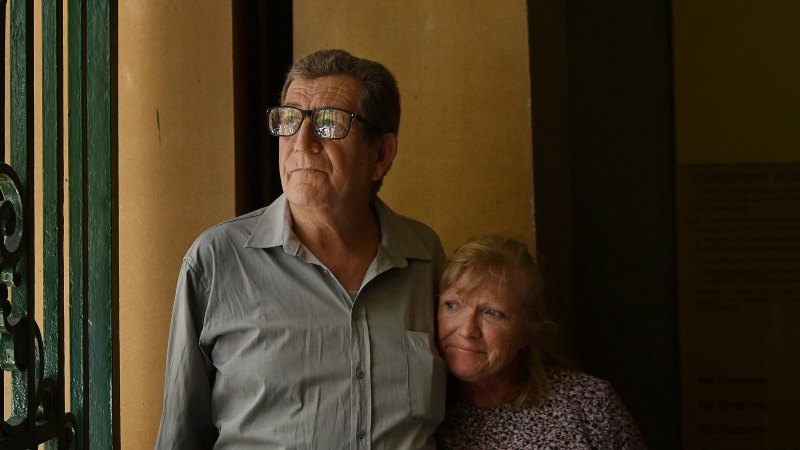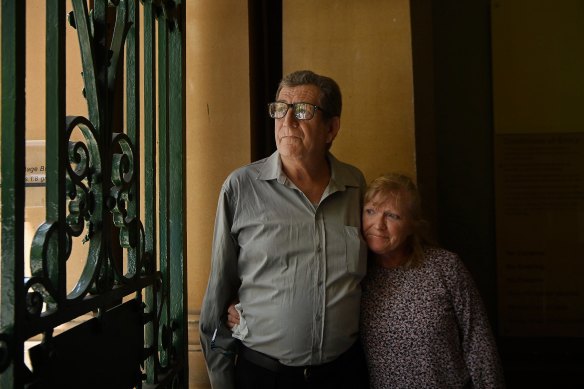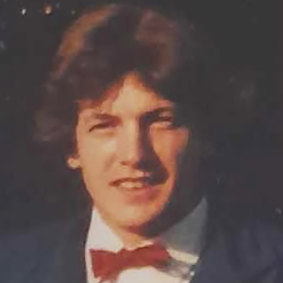Save articles for later
Add articles to your saved list and come back to them any time.
Family members whose loved ones’ deaths were examined by a world-first inquiry have expressed regret the cold cases were not investigated sooner by police, amid revelations that key exhibits and records have been lost.
The state’s landmark special commission of inquiry into LGBTIQ hate crimes was packed with supporters at its final hearing in Sydney on Tuesday ahead of the delivery of the final report on December 15.
Peter Russell, left, the brother of John Russell, and his partner Donna Hannah outside the LGBTIQ hate crimes inquiry on Tuesday.Credit: Kate Geraghty
Among the suspected bias crimes examined by the inquiry was the death of John Russell, 31, whose body was found on the rocks beneath the Bondi to Tamarama coastal walk in 1989 near a known gay beat.
The inquiry has heard hairs found on Russell’s left hand were lost by police by 1990 and never forensically examined. A cigarette packet, lighter and Coca-Cola bottle found near his body also appeared to have been lost, and his clothes were washed.
His brother Peter Russell said outside the hearing that the inquiry had been a “long journey”, and “the whole family has been let down by the NSW Police Force a long time ago”.
“If they had’ve looked after that evidence, I wouldn’t be standing here now,” he said.
‘Sadly, I feel that the police actions were grossly inadequate at the time.’
Russell said that “somebody obviously knows something, but … if they don’t say anything soon it will all go to the grave with them”.
Asked if he had a message for his brother, Russell said: “You’re still massively loved. You’re missed.”
The final report of the inquiry, headed by Supreme Court Justice John Sackar, is expected to include a confidential section to avoid prejudicing any potential future investigations and prosecutions. Sackar said in his closing remarks that “hatred and prejudice against any person because of their identity is an affront to a civilised society”.
John Russell, aged about 21. Ten years later, in 1989, his body was found at the base of the sea cliffs at Bondi.
Lynette Elias, whose brother’s death was examined by the inquiry, said she was thankful for its work.
“Sadly, I feel that the police actions were grossly inadequate at the time and in my situation I think we could have found out so much more,” she said.
Senior counsel assisting the inquiry, Peter Gray, SC, said in his final remarks that “hard truths have certainly been told” and “many voiceless people have been given a voice”.
The inquiry had a dual task of examining all unsolved suspected LGBTIQ hate crime deaths in NSW between 1970 and 2010, as well as any unsolved potential bias crimes among more than 80 deaths previously reviewed by NSW Police under Strike Force Parrabell.
The inquiry ultimately identified four suspected hate crime deaths from more than 700 unsolved homicides in NSW, and a further 20 were drawn from Parrabell.
SUSPECTED BIAS CRIMES
- The inquiry reviewed every unsolved homicide in NSW between 1970 and 2010, totalling more than 700 cases, to find suspected LGBTIQ hate crime deaths.
- It also examined a NSW Police review of more than 80 deaths potentially motivated by gay hate bias, dubbed Strike Force Parrabell.
- The inquiry identified 22 deaths from Parrabell that were considered to be unsolved. Counsel assisting submitted that 20 of the 22 were homicides (14 deaths) or suspected homicides (6 deaths).
- There was “reason to suspect that LGBTIQ bias was a factor” in each of those 20 deaths, senior counsel assisting the inquiry, Peter Gray, SC, said.
- By contrast, Strike Force Parrabell had said in 2018 that just five of the 23 cases it considered unsolved at that time were suspected bias crimes.
- The inquiry identified a further four deaths as suspected hate crime deaths following its review of all unsolved homicides in the 40 years from 1970 to 2010.
Gray said four was a “lower than expected” number but the inquiry revealed considerable gaps in police records, the inquiry had finite time and resources, and it was “unfortunately possible that cases have been missed”.
Gray said there was reason to suspect LGBTIQ bias was a factor in all 20 of the unsolved Parrabell cases that the inquiry concluded were actual or suspected homicides.
By contrast, Strike Force Parrabell said in 2018 that just five of the 23 deaths it considered unsolved at that time were suspected bias crimes.
The inquiry identified a number of leads, including persons of interest in the 1993 cold case murder of former AC/DC manager Crispin Dye and the 1976 killing of Ernest Head in Summer Hill. While both suspects are now dead, there is the potential for further persons of interest to emerge in the Dye case.
The inquiry also exposed major shortcomings in NSW Police storage and retention of exhibits.
The relationship between the inquiry and NSW Police has been marked by tensions. Gray said the force had made “significant efforts since the 1990s to reassess and improve the ways in which it relates to the LGBTIQ community”.
However, he said that strike forces including a reinvestigation of the suspected deaths of Russell and two other men near the Bondi to Tamarama walk, Ross Warren and Gilles Mattaini, appeared to betray an “attitude … resistant to acknowledging the extent of the hostility experienced by LGBTIQ people in the 40-year period under examination”.
Gray also noted NSW Police publicly expressed their support for the inquiry but adopted positions that “often gave the appearance of a defensive if not adversarial mindset”.
Start the day with a summary of the day’s most important and interesting stories, analysis and insights. Sign up for our Morning Edition newsletter.
Most Viewed in National
From our partners
Source: Read Full Article


